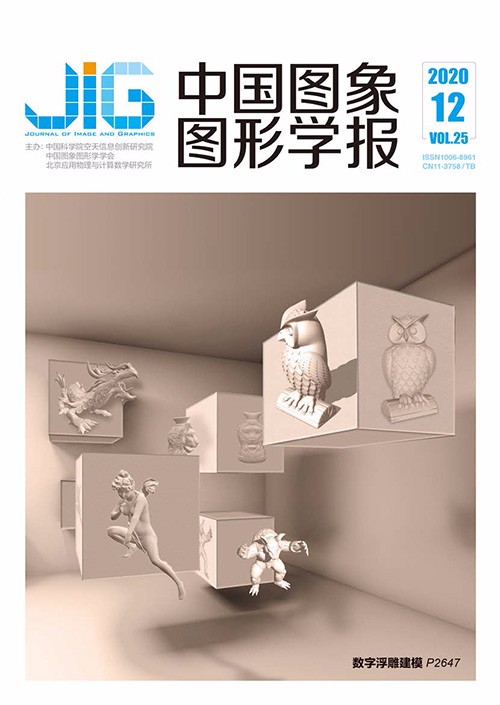
针对形变与遮挡问题的行人再识别
摘 要
目的 姿态变化和遮挡导致行人表现出明显差异,给行人再识别带来了巨大挑战。针对以上问题,本文提出一种融合形变与遮挡机制的行人再识别算法。方法 为了模拟行人姿态的变化,在基础网络输出的特征图上采用卷积的形式为特征图的每个位置学习两个偏移量,偏移量包括水平和垂直两个方向,后续的卷积操作通过考虑每个位置的偏移量提取形变的特征,从而提高网络应对行人姿态改变时的能力;为了解决遮挡问题,本文通过擦除空间注意力高响应对应的特征区域而仅保留低响应特征区域,模拟行人遮挡样本,进一步改善网络应对遮挡样本的能力。在测试阶段,将两种方法提取的特征与基础网络特征级联,保证特征描述子的鲁棒性。结果 本文方法在行人再识别领域3个公开大尺度数据集Market-1501、DukeMTMC-reID和CUHK03(包括detected和labeled)上进行评估,首位命中率Rank-1分别达到89.52%、81.96%、48.79%和50.29%,平均精度均值(mean average precision,mAP)分别达到73.98%、64.45%、43.77%和45.58%。结论 本文提出的融合形变与遮挡机制的行人再识别算法可以学习到鉴别能力更强的行人再识别模型,从而提取更加具有区分性的行人特征,尤其是针对复杂场景,在发生行人姿态改变及遮挡时仍能保持较高的识别准确率。
关键词
Person re-identification based on deformation and occlusion mechanisms
Shi Weidong, Zhang Yunzhou, Liu Shuangwei, Zhu Shangdong, Bao Jining(College of Information Science and Engineering, Northeastern University, Shenyang 110819, China) Abstract
Objective Person re-identification (re-ID) identifies a target person from a collection of images and shows great value in person retrieval and tracking from a collection of images captured by network cameras. Due to its important applications in public security and surveillance, person re-ID has attracted the attention of academic and industrial practitioner sat home and abroad. Although most existing re-ID methods have achieved significant progress, person re-ID continues to face two challenges resulting from the change of view in different surveillance cameras. First, pedestrians have a wide range of pose variations. Second, some people in public spaces are often occluded by various obstructions, such as bicycles or other people. These problems result in significant appearance changes and may introduce some distracting information. As a result, the same pedestrian captured by different cameras may look drastically different from each other and may prevent re-ID. One simple, effective method for addressing this problem is to obtain additional pedestrian samples. Using abundant practical scene images can help generate more post-variant and occluded samples, thereby helping re-ID systems achieve excellent robustness in complex situations. Some researchers have considered the representations of both the image and the key point-based pose as inputs to generate target poses and views via the generative adversarial networks (GAN) approach. However, GAN usually suffers from a convergence problem, and the generated target images usually have poor texture. In random erasing, a rectangle region is randomly selected from an image or feature map, and the original pixel value is discarded afterward to generate occluded examples. However, this approach only creates hard examples by spatially blocking the original image and (similar to the methods mentioned above) is very time consuming. To address these problems, we propose a person re-ID algorithm that generates hard deformation and occlusion samples. Method We use a deformable convolution module to simulate variations in pedestrian posture. The 2D offsets of regular grid sampling locations on the last feature map of the ResNet50 network are calculated by other branches that contain a multiple convolutional layer structure. These 2D offsets include the horizontal and vertical values X and Y. Afterward, these offsets are reapplied to the feature maps to produce new feature maps and deformable features via resampling. In this way, the network can change the posture of pedestrians in both horizontal and vertical directions and subsequently generate deformable features, thereby improving the ability of the network in dealing with deformed images. To address the occlusion problem, we generate spatial attention maps by using the spatial attention mechanism. We also apply other convolutional operations on the last feature map of the ResNet50 backbone to produce a spatial attention map that highlights the important spatial locations. Afterward, we mask out the most discriminative regions in the spatial attention map and retain only the low responses by using a fixed threshold value. The processed spatial attention map is then multiplied by the original features to produce the occluded features. In this way, we simulate the occluded pedestrian samples and further improve the ability of the network to adapt to other occluded samples. In the testing, we cascade two features with the original features as our final descriptors. We implement and train our network by using Pytorch and an NVIDIA TITAN GPU device, respectively. We set the batch size to 32 and rescaled all images to a fixed size of 256×128 pixels during the training and testing procedures. We also adopt a stochastic gradient descent (SGD) with a momentum of 0.9 and weight decay coefficient of 0.000 5 to update our network parameters. The initial learning rate is set to 0.04, which is further divided by 10 after 40 epochs (the training process has 60 epochs). We fix the reduction ratio and erasing threshold to 16 and 0.7 in all datasets, respectively. We adopt random flip as our data augmentation technique, and we use ResNet50 as our backbone model that contains parameters that are pre-trained on the ImageNet dataset. This model is also trained end-to-end. We adopt cumulative match characteristic (CMC) and mean average precision (mAP) to compare the re-ID performance of the proposed method with that of existing methods. Result The performance of our proposed method is evaluated on public large-scale datasets Market-1501, DukeMTMC-reID, and CUHK03. We use a uniform random seed to ensure the repeatability of the equity comparison and the results. In the Market-1501, DukeMTMC-reID, and CUHK03 (detected and labeled) datasets, the proposed method has obtained Rank-1 (represents the proportion of the queried people) values of 89.52%, 81.96%, 48.79%, and 50.29%, respectively, while its mAP values in these datasets reach 73.98%, 64.45%, 43.77%, and 45.57%, respectively. In the detected and labeled CUHK03 datasets, the proposed method shows 9.43%/8.74% and 8.72%/8.0% improvements in its Rank-1 and mAP values, respectively. These experimental results validate the competitive performance of this method for small and large datasets. Conclusion The proposed person re-ID system based on the deformation and occlusion mechanisms can construct a highly recognizable model for extracting robust pedestrian features. This system maintains high recognition accuracy in complex application scenarios where occlusion and wide variations in pedestrian posture are observed. The proposed method can also effectively mitigate model overfitting in small-scale datasets (e.g., CUHK03 dataset), thereby improving its recognition rate.
Keywords
|



 中国图象图形学报 │ 京ICP备05080539号-4 │ 本系统由
中国图象图形学报 │ 京ICP备05080539号-4 │ 本系统由